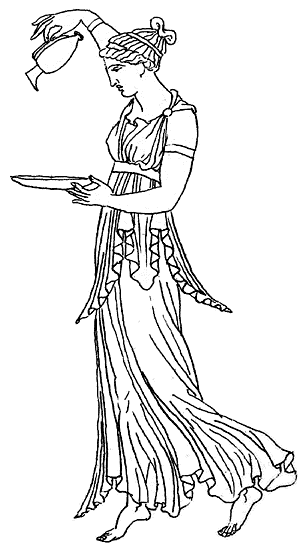
Empire silhouette
Encyclopedia


Skirt
A skirt is a tube- or cone-shaped garment that hangs from the waist and covers all or part of the legs.In the western world, skirts are usually considered women's clothing. However, there are exceptions...
, which skims the body. The outline is especially flattering to pear shapes wishing to disguise the stomach area or emphasise the bust. The shape of the dress also helps to lengthen the body's appearance. Here the word "Empire" refers to the period of the First French Empire
First French Empire
The First French Empire , also known as the Greater French Empire or Napoleonic Empire, was the empire of Napoleon I of France...
.
Early examples of the style can be seen on women from early Greco-Roman art wearing loose fitting rectangular tunics known as Peplos
Peplos
A peplos is a body-lengthGreek garment worn by women before 500 BC. The peplos is a tubular cloth folded inside-out from the top about halfway down, altering what was the top of the tube to the waist and the bottom of the tube to ankle-length. The garment is then gathered about the waist and the...
or the more common Chiton
Chiton (costume)
A chiton was a form of clothing worn by men and women in Ancient Greece, from the Archaic period to the Hellenistic period ....
which were belted under the bust, providing support for women and a cool, comfortable outfit suitable for the warm climate.
The last few years of the 18th century first saw the style coming into fashion in Western and Central Europe (and European-influenced areas). The look was popularized in Britain by Emma, Lady Hamilton
Emma, Lady Hamilton
Emma, Lady Hamilton is best remembered as the mistress of Lord Nelson and as the muse of George Romney. She was born Amy Lyon in Ness near Neston, Cheshire, England, the daughter of a blacksmith, Henry Lyon, who died when she was two months old...
, who designed such garments for her performances of poses in imitation of classical antiquity ("attitudes"), which were a sensation throughout Europe. Paris in the second half of the 1790s was the center of adoption of strongly neo-classical influenced styles as mainstream fashion. In France the style was sometimes called "à la grecque" after decorations found on Grecian urns.
The Empire silhouette contributed to making clothes of the 1795–1820 period generally less confining and cumbersome than high-fashion clothes of the rest of the 18th and 19th centuries.
The style evolved through the Napoleonic era
Napoleonic Era
The Napoleonic Era is a period in the history of France and Europe. It is generally classified as including the fourth and final stage of the French Revolution, the first being the National Assembly, the second being the Legislative Assembly, and the third being the Directory...
until the early 1820s
1820s in fashion
During the 1820s in European and European-influenced countries, fashionable women's clothing styles transitioned away from the classically-influenced "Empire"/"Regency" styles of ca...
, after which the hourglass Victorian styles became more popular. The style was often worn in white to denote a high social status (especially in its earlier years); only women solidly belonging to what in England was known as the "genteel" classes could afford to wear the pale, easily soiled garments of the era. The complete and drastic contrast between 1790s styles (especially those of the second half of the decade) and the constricting and voluminous styles of the 1770s (with a rigid cylindrical torso above panniers
Pannier (clothing)
Panniers or side hoops are women's undergarments worn in the 18th century to extend the width of the skirts at the side while leaving the front and back relatively flat...
) is probably partially due to the French political upheavals after 1789 (though there is not usually any very simple or direct correlation between political events and fashion changes). English women's styles (often referred to as "regency
English Regency
The Regency era in the United Kingdom is the period between 1811—when King George III was deemed unfit to rule and his son, the Prince of Wales, ruled as his proxy as Prince Regent—and 1820, when the Prince Regent became George IV on the death of his father....
") followed along the same general trend of raised waistlines
Waistline (clothing)
The waistline is the line of demarcation between the upper and lower portions of a garment, which notionally corresponds to the natural waist but may vary with fashion from just below the bust to below the hips. The waistline of a garment is often used to accentuate different features...
as French styles, even when the countries were at war.
The 1960s saw a revival of the style, possibly reflecting the less strict social mores of the era (similar to when the unconstricting 1920s "flapper
Flapper
Flapper in the 1920s was a term applied to a "new breed" of young Western women who wore short skirts, bobbed their hair, listened to jazz, and flaunted their disdain for what was then considered acceptable behavior...
" styles replaced the heavy corsetry of the early 1900s).
The term "Empire silhouette" emerged in early 20th century Britain; the word "empire" here is now pronounced with a special quasi-French pronunciation (om-peer) by many in the fashion world.
See also
- 1750–1795 in fashion
- 1795–1820 in fashion
- Corset controversyCorset controversyThe corset controversy is an ensemble of letters and articles concerning the corset that appeared in newspapers and periodicals in the 19th century.-Introduction:...
- Emma, Lady HamiltonEmma, Lady HamiltonEmma, Lady Hamilton is best remembered as the mistress of Lord Nelson and as the muse of George Romney. She was born Amy Lyon in Ness near Neston, Cheshire, England, the daughter of a blacksmith, Henry Lyon, who died when she was two months old...
- FlapperFlapperFlapper in the 1920s was a term applied to a "new breed" of young Western women who wore short skirts, bobbed their hair, listened to jazz, and flaunted their disdain for what was then considered acceptable behavior...

